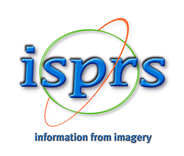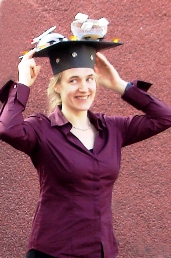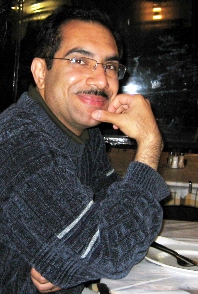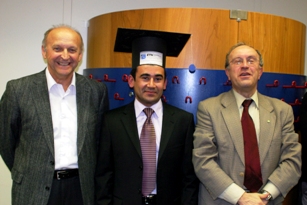|
Three new PhDs in one week at the Chair of Photogrammetry and Remote Sensing of ETH Zurich
by Thomas Hanusch, IGP, ETH Zurich
Since the 12th week of this year, the scientific community of photogrammetry and remote sensing is enriched by three new PhD's.
Congratulations!!
|
|
|
|
|

 Ms. Kirsten Wolff, responsible for the organisation of the post graduate course for Spatial Information Systems at ETH Zurich, defended her thesis in the group of Photogrammetry, at the University of Bonn under supervision of Prof. Dr.-Ing. Wolfgang Förstner (University Bonn, Germany) and co-supervision of Prof. Dr. Hans-Peter Helfrich (University Bonn, Germany) and Prof. Dr. habil Hans-Gerd Maas (TU Dresden, Germany), on the 15th of March. Her thesis "Zur Approximation allgemeiner optischer Abbildungsmodelle und deren Anwendung auf eine geometrisch basierte Mehrbildzuordnung am Beispiel einer Mehrmedienabbildung" was graded as "magna cum laude". Her work deals basically with geometric characteristics of non-perspective optical mappings, especially with different kinds of viewpoints (single or non single viewpoints), resulting image distortion (image or object space based) and the influence on 3D object generation. It gives a new representation and classification of optical mapping systems considering the type of their single or multiple viewpoints and the resulting image distortion. A new efficient approximation of complex, object space-based distorted maps by one or more local virtual cameras is used for the matching module of a new algorithm for a geometrical image matching with multiple views, without significant influence on the results. The methods and algorithms were tested for a reconstruction of a fluvial sediment surface with the classical three media geometry (air, plexiglass and water). After her PhD, she continues her work in the group of Photogrammetry and Remote sensing at ETH Zurich.
Ms. Kirsten Wolff, responsible for the organisation of the post graduate course for Spatial Information Systems at ETH Zurich, defended her thesis in the group of Photogrammetry, at the University of Bonn under supervision of Prof. Dr.-Ing. Wolfgang Förstner (University Bonn, Germany) and co-supervision of Prof. Dr. Hans-Peter Helfrich (University Bonn, Germany) and Prof. Dr. habil Hans-Gerd Maas (TU Dresden, Germany), on the 15th of March. Her thesis "Zur Approximation allgemeiner optischer Abbildungsmodelle und deren Anwendung auf eine geometrisch basierte Mehrbildzuordnung am Beispiel einer Mehrmedienabbildung" was graded as "magna cum laude". Her work deals basically with geometric characteristics of non-perspective optical mappings, especially with different kinds of viewpoints (single or non single viewpoints), resulting image distortion (image or object space based) and the influence on 3D object generation. It gives a new representation and classification of optical mapping systems considering the type of their single or multiple viewpoints and the resulting image distortion. A new efficient approximation of complex, object space-based distorted maps by one or more local virtual cameras is used for the matching module of a new algorithm for a geometrical image matching with multiple views, without significant influence on the results. The methods and algorithms were tested for a reconstruction of a fluvial sediment surface with the classical three media geometry (air, plexiglass and water). After her PhD, she continues her work in the group of Photogrammetry and Remote sensing at ETH Zurich. On the 20th of March, Mr. Jafar Amiri Parian defended his thesis "Sensor modeling, camera calibration and network analysis for panoramic cameras" successfully. The supervisor Prof. Dr. Armin Gruen (ETH Zurich, Switzerland) and the co-supervisors Associate Professor Ali Azizi (University of Tehran, Iran), Prof. Dr. habil. Hans-Gerd Maas as well as the Chairman of the Examination Committee Prof. Dr. Lorenz Hurni (Institute of Cartography, ETH Zurich), certified him an excellent work during the last years and an outstanding thesis. He developed a sensor model for terrestrial linear array-based panoramic cameras by means of additional parameters, which models substantial deviations of a physical camera from the ideal one. Through the joint sensor model of terrestrial linear array-based panoramic cameras and terrestrial laser scanners, laser scanners can be calibrated as well. He used 3D straight-line information in addition to tie points to conduct a full calibration and orientation without control point information. In further steps, he analyzed several close-range networks of linear array-based panoramic camera stations through computer heuristic simulation in order to assess their precision and reliability structure. Actually, he temporarily works now on a joint project with the European Space Agency (ESA) at the European Space Research and Technology Centre (ESTEC) in the Netherlands as a Postdoc.
On the 20th of March, Mr. Jafar Amiri Parian defended his thesis "Sensor modeling, camera calibration and network analysis for panoramic cameras" successfully. The supervisor Prof. Dr. Armin Gruen (ETH Zurich, Switzerland) and the co-supervisors Associate Professor Ali Azizi (University of Tehran, Iran), Prof. Dr. habil. Hans-Gerd Maas as well as the Chairman of the Examination Committee Prof. Dr. Lorenz Hurni (Institute of Cartography, ETH Zurich), certified him an excellent work during the last years and an outstanding thesis. He developed a sensor model for terrestrial linear array-based panoramic cameras by means of additional parameters, which models substantial deviations of a physical camera from the ideal one. Through the joint sensor model of terrestrial linear array-based panoramic cameras and terrestrial laser scanners, laser scanners can be calibrated as well. He used 3D straight-line information in addition to tie points to conduct a full calibration and orientation without control point information. In further steps, he analyzed several close-range networks of linear array-based panoramic camera stations through computer heuristic simulation in order to assess their precision and reliability structure. Actually, he temporarily works now on a joint project with the European Space Agency (ESA) at the European Space Research and Technology Centre (ESTEC) in the Netherlands as a Postdoc. On Friday morning, the 23rd of March, Mr. Devrim Akca defended his PhD thesis "Least Squares 3D Surface Matching", under supervision of Prof. Dr. Armin Gruen and co-supervision of Prof. Dr. Orhan Altan (Istanbul Technical University, Turkey). The Chairman of the Examination Committee was Prof. Dr. Lorenz Hurni. Devrim Akca convinced with a well prepared presentation and an excellent thesis. His work gives a generalization of the 2D Least Squares image matching technique to a 3D surface matching problem. The proposed method estimates the transformation parameters of one or more fully 3D search surfaces with respect to a template one, using the Generalized Gauss-Markoff model. Beside the mathematical model of the procedure, a comprehensive discussion was given about the implementation details, precision and reliability issues, and convergence behaviour. In addition, an extension of the model was proposed for simultaneously matching of intensity and geometry information under a combined estimation model. The developed algorithm offers a high level of flexibility for many kinds of 3D surface corresponding problems. He also showed the application of this new technique in many diverse projects. Now he works in a Postdoc position in two research projects at the Group of Photogrammetry and Remote Sensing at ETH Zurich. This past week in March was a period of great expectations and excitement at the Chair of Photogrammetry and Remote Sensing. But at the end, when all exams are successfully passed, a great satisfaction takes place that another ambitious group of excellent young scientists has completed an important step in their life.
On Friday morning, the 23rd of March, Mr. Devrim Akca defended his PhD thesis "Least Squares 3D Surface Matching", under supervision of Prof. Dr. Armin Gruen and co-supervision of Prof. Dr. Orhan Altan (Istanbul Technical University, Turkey). The Chairman of the Examination Committee was Prof. Dr. Lorenz Hurni. Devrim Akca convinced with a well prepared presentation and an excellent thesis. His work gives a generalization of the 2D Least Squares image matching technique to a 3D surface matching problem. The proposed method estimates the transformation parameters of one or more fully 3D search surfaces with respect to a template one, using the Generalized Gauss-Markoff model. Beside the mathematical model of the procedure, a comprehensive discussion was given about the implementation details, precision and reliability issues, and convergence behaviour. In addition, an extension of the model was proposed for simultaneously matching of intensity and geometry information under a combined estimation model. The developed algorithm offers a high level of flexibility for many kinds of 3D surface corresponding problems. He also showed the application of this new technique in many diverse projects. Now he works in a Postdoc position in two research projects at the Group of Photogrammetry and Remote Sensing at ETH Zurich. This past week in March was a period of great expectations and excitement at the Chair of Photogrammetry and Remote Sensing. But at the end, when all exams are successfully passed, a great satisfaction takes place that another ambitious group of excellent young scientists has completed an important step in their life.